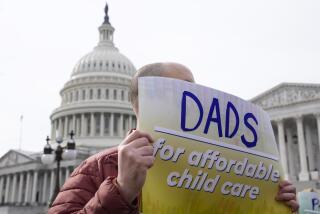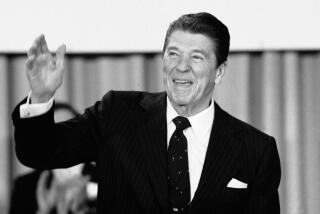Dukakis Takes Risk in Offering College Aid Plan : New Ideas Can Help a Presidential Candidate but May Also Backfire
- Share via
WASHINGTON — Democratic presidential candidate Michael S. Dukakis did something highly unusual earlier this month. He introduced a new idea into the presidential election campaign--a proposal to guarantee that every student could borrow the money needed for college.
According to civics textbooks, specific proposals such as Dukakis’ help candidates win elections. John F. Kennedy’s proposed Peace Corps not only stirred potential volunteers among the young but also demonstrated to older voters that the candidate was a man of vision and ideals, and it helped carry him to his narrow presidential victory in 1960.
However, the strategy on which Dukakis embarked entails the risk that the candidate will be attacked on the very specifics that are designed to be appealing. It is for this reason that carefully crafted proposals are so rare in presidential election campaigns.
McGovern Suffered Ridicule
Thus, George S. McGovern’s plan to give $1,000 to every American, rich or poor, won him only ridicule in 1972. And Adlai E. Stevenson’s proposal to end the military draft, although finally embraced by the nation years later, pushed him further into humiliating defeat in 1956.
Dukakis’ college loan plan--the most specific proposal of either candidate--was part of a conscious strategy to revive his faltering campaign against George Bush. All students could borrow; instead of paying the loan back quickly after graduation, they would pay back a certain percentage of their earnings--Dukakis has suggested 0.125% for every $1,000 borrowed--for the rest of their lives.
To the candidate’s advisers, the plan had the advantage of displaying the Massachusetts governor as an innovative problem solver who takes the financial concerns of the middle class seriously. Dukakis has focused much of his campaign on the economic squeeze on the middle class, and he has tried to position himself as a competent leader who can get things done.
Yet the specifics of Dukakis’ college loan proposal are already attracting criticism. In particular, detractors are charging that Dukakis’ plan, designed to cost the government nothing, would in fact soak the federal Treasury because only students with low expected earnings would participate.
Aiding Many Voters
Stephen J. Wayne, a political scientist at George Washington University, said that the Dukakis plan fits into a long tradition of presidential campaign proposals promising to benefit large numbers of voters.
“The new twist,” said Wayne, a specialist on electoral politics, “is the issue of the deficit. Now, every time you propose something, you have to answer how the hell we can pay for it.”
Cost was not an issue when Kennedy advanced his Peace Corps proposal in 1960. In fact, unlike the Dukakis college loan plan, the Peace Corps plan seems to have sprung up without much thought.
Kennedy, speaking at a 2 a.m. rally at the University of Michigan on Oct. 14, 1960, issued a challenge to several thousand enthusiastic students.
‘10 Years in Africa’
“How many of you are willing to spend 10 years in Africa or Latin America or Asia working for the U.S. and working for freedom?” he asked. “ . . . On your willingness to contribute part of your life to this country, I think, will depend the answer to whether we as a free society can compete.”
Kennedy probably had nothing more in mind than some stirring oratory that would fix him in the minds of young people as a dynamic leader concerned about the American role in the developing world.
But the idea took off, almost on its own. Students at Michigan and other campuses accepted Kennedy’s challenge and flooded his campaign headquarters with offers to serve.
At almost the same time, Gen. James M. Gavin, the paratrooper hero of World War II, independently proposed that young Americans be given a chance to serve as volunteers in the developing world as an alternative to military service. And Sen. Hubert H. Humphrey (D-Minn.) had introduced legislation to create an agency of American volunteers to help the developing world.
The Kennedy staff put together the Michigan challenge, the student fervor, the Gavin proposals and the Humphrey legislation, coined a new name and came up with the Peace Corps. Kennedy formally proposed it in a speech in San Francisco six days before the election.
Twelve years later, McGovern was not so well served by his own effort to inject specifics into his election campaign against Richard M. Nixon.
Like Kennedy, McGovern broached his proposal on campus. In a rambling speech to a group of Iowa State University students during the 1972 Democratic primary, McGovern offered numerous ideas for dealing with the economy. One struck many listeners and reporters as bizarre.
$1,000 for Everyone
McGovern proposed that the government grant every American, from millionaires to unwed teen-age mothers, the sum of $1,000. The scheme was founded on widely discussed academic ideas--known as income equalization or negative income tax--for funneling funds to the poor.
But neither McGovern nor his aides came up with an intelligible explanation of how to finance the plan. Moreover, it smacked too much of old, discredited ideas such as Huey Long’s “share the wealth” and the Canadian social credit proposals in the 1930s.
“On the surface,” wrote Theodore White in his account of the 1972 election, “it appeared like the purest biblical utopianism.”
Nor can Dukakis take solace from the precedent of 1956, when Stevenson proposed an end to the draft in peacetime and the start of negotiations for a treaty banning the testing of nuclear arms.
‘Theatrical’ Gesture
On such matters, the voters preferred the leadership of President Dwight D. Eisenhower, the most celebrated American general of World War II. Eisenhower denounced the Stevenson proposals as “a theatrical national gesture” and “a strange new formula” for peace.
Although Eisenhower handily defeated Stevenson, a treaty banning all but underground nuclear tests was signed in 1963, and President Nixon, fulfilling his own campaign promise of 1972, abolished the draft in 1973.
President Reagan tried his own hand during his 1980 campaign for the presidency, when he promised to cut taxes, increase military spending and balance the budget all at the same time.
Tax cuts were not a new idea. Economist Arthur Laffer postulated that a tax cut would so stimulate the economy that it would actually increase government revenues, and Rep. Jack Kemp (R-N. Y.) and other members of Congress had embraced the idea.
Budget Like Virtue
However, Reagan promised also to increase military spending and balance the budget within a couple of years. He told the voters that balancing the budget was “like protecting your virtue--you just have to say no.”
A large number of economists had as many doubts about that as they had had about the McGovern proposals eight years earlier. Bush, campaigning against Reagan for the Republican nomination, derided his plan as “voodoo economics.” Even some of Reagan’s economic advisers, according to New Yorker writer Elizabeth Drew, found the theories “a bit exotic and questionable.”
Reagan easily unseated President Jimmy Carter, and soaring deficits quickly proved the skeptics right. Perhaps the lesson for Dukakis is that, in presidential election campaigns, personalities and images count far more than concrete policy proposals.
More to Read
Get the L.A. Times Politics newsletter
Deeply reported insights into legislation, politics and policy from Sacramento, Washington and beyond. In your inbox twice per week.
You may occasionally receive promotional content from the Los Angeles Times.









